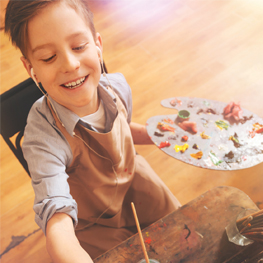
The toddler and preschool years are filled with discovery and exploration. We want our children to have creative experiences, and we expose them to new materials. We take our toddlers to art class, dance class, and parent-and-me music lessons. We take our preschoolers to hands-on museums; bring out the finger paint and glitter to make Valentine’s and other holiday crafts for class parties; buy coloring books, and chubby markers for little fingers.
But what happens when our children reach those pre-teen and teen years? When they are too old to go to the toy store and when they’re no longer asking for art kits? When children’s museums and parent-and-me music classes are a thing of the past? Many of us don’t know what to do, and we resort to the default and relegate our children’s free time to scheduled activities, sports, homework, or screen time. And as our children get older, they begin to have more ‘high-tech’ experiences instead of ‘high-touch’ ones.
Lucia Capacchione talks about the importance of ‘high-touch’ experiences in her book, The Creative Journal: The Art of Finding Yourself. She states that humans need high-touch media, such as simple, hands-on art materials. These experiences allow for emotional expression, creative spontaneity, discovery, and personal insight. While ‘high-tech’ devices have their place, they also limit physical movements and these experiences provide an entirely different kind of mind-body connection.
Teenagers need these high-touch experiences to grow. Creative outlets become important in their lives as they have some way to express themselves when they become anxious or depressed. Many teens hardly ever get to hold a pen and hear the sound it makes as it scratches across the surface of the paper, as many schools rely on computers or tablets that students use to complete and submit homework. And by the time your child reaches high school, most art and music classes become optional and are abandoned for other options that will look good on a post-secondary resume.
Not sure how to make creative space in the life of your teen? Try one, or more, of these suggestions:
1. Look for drop-in programs. Art centres, community centres, local libraries (to name just a few) often have drop-in programs that engage teens and create a space where they are able to explore. Programs should be open-ended, meaning they’re more focused on the process rather than on creating any sort of product. Teens especially need a place where they can try out their own ideas in a safe place. Exploring and creating with art supplies or musical instruments is a great way for them to try new things and experience failure in a supportive environment.
2. Films on creativity. Movies can be a great way to start conversations about creativity and can work to inspire the teen in your life. Some documentaries that explore the artistic life are Exit Through the Gift Shop (about street art), Between the Folds (about the incredible things artists are doing with paper), Imba Means Sing (about the African Children’s Choir and their North American Tour), or Most Valuable Players (follows three high school musical productions). Depending on your comfort level and the maturity of your child, some language and/or scenes might not be suitable; it’s always a good idea to preview any movie in its entirety before sharing with your teen.
3. Create your own ‘drop-in’program. This doesn’t need to be anything fancy. Invite some of your teen’s friends over and set up some simple art materials for them to use (I like to use the acrylic paints from Michaels). I leave these out in a bin in my dining room, which has the longest table in the house, that is always covered with a disposable tablecloth and sketchbooks. Leave these supplies around and see what happens! There are numerous tutorials on YouTube that can help get you started.
4. Take regular creativity trips. Julia Cameron, in her book, The Artist’s Way, introduces the idea of Artist Dates. A date consists of “a block of time especially set aside and committed to nurturing your creative consciousness, your inner artist.” If cost is an issue, many museums have special nights during the year where admission is waived or low cost. And outdoor concerts are a big thing during the summer months where many of them are free or low cost at local parks where teens can explore their inner artist.
5. Kick-start your own creative life. Maybe there’s something creative you used to do or that you haven’t done in a while, so break out that saxophone and brush up on your scales or dust off your art supplies and set up that easel in the corner and let the sparks fly! Or it could be the perfect time to take that watercolor or scrapbooking class that you’ve always wanted to but haven’t got up the nerve yet. It’s never too late to start and you would be a great role model to show your children that creativity is important, no matter what stage of life you’re in. And who knows, maybe your teen will even ask to take a class with you!
Krystyann Krywko, Ed.D., is a writer and the founder of the Be Brave Every Day visual journaling workshop. As a former Montessori teacher, she believes that children can create their own magic when provided with the right materials.
Calgary’s Child Magazine © 2024 Calgary’s Child